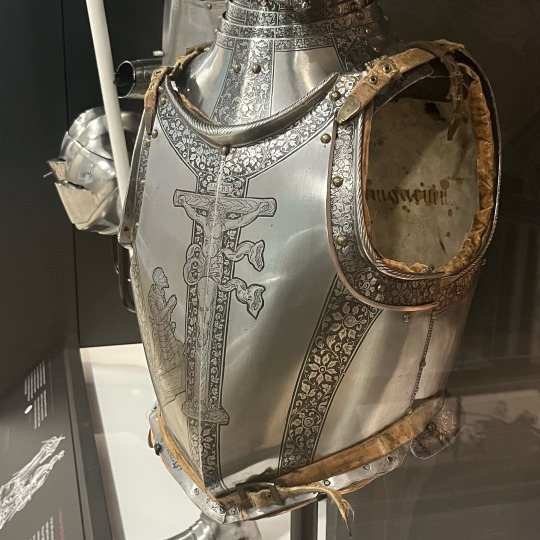#medieval
Text

A portrait of Godzilla attributed to Giotto.
90 notes
·
View notes
Text




In the tavern
#medieval reenactment#medieval#medievalcore#medieval fantasy#fantasy#fantasycore#dnd#photography#tavern#inn#history#aesthetic#i’ll be on my merry way now
116 notes
·
View notes
Text
Explore the medieval weapon chest from the 1495 sunken ship Gribshunden, revealing new insights into late medieval naval warfare. Don't miss the detailed 3D video walkthrough!
79 notes
·
View notes
Text

The Boyhood of Alfred the Great by Edmund Blair Leighton
#alfred the great#osburh#osburga#mother#boyhood#art#edmund blair leighton#edmund leighton#wessex#anglo saxon#anglo saxons#history#english#england#middle ages#medieval#osburga oslacsdotter#education#christian#christianity#mediaeval#royal#royalty#royals
59 notes
·
View notes
Text




more armoury photos bc i want to go back and sketch there more
29 notes
·
View notes
Text
i figured yall would appreciate this photo

original instagram post from vinnikolaus
44K notes
·
View notes
Text


Merry Christmas sleepyheads !
23K notes
·
View notes
Text






animals in medieval armor
14K notes
·
View notes
Text

Heath Ledger - May 2000 - by Bruce Weber.
#heath ledger#a knight's tale#film#2000s#movies#celebs#cinema#knight#medieval#actor#sword#brokeback mountain#bruce weber#retro#fantasy#armor#the joker#lit#culture#geoffrey chaucer#the canterbury tales#📚
10K notes
·
View notes
Text

13K notes
·
View notes
Text

they were confreres in christ
9K notes
·
View notes
Text

Paco Rabanne by Thierry Le Gouès. 1998
#1990s fashion#fashion photography#editorial#editorial photoshoot#editorial photography#chainmail#knight#midevial#mideval#female knight#paco rabanne#medieval
7K notes
·
View notes
Text

By Mystical Antiquity
#art#artist#illustration#medieval#armor#knight#damsel#princess#fantasy#high fantasy#mine#Mystical Antiquity
6K notes
·
View notes
Text
Preindustrial travel, and long explanations on why different distances are like that
Update March 1, 2024: Hey there folks, here's yet another update! I reposted Part 2a (the "medieval warhorses" tangent) to my writing blog, and I went down MORE of the horse-knowledge rabbit hole! https://www.tumblr.com/jadevine/741423906984951808/my-post-got-cut-off-so-i-added-the-rest-of-it
Update Jan 30, 2024: Hey folks, I've posted the updated version of this post on my blog, so I don't have to keep frantically telling everyone "hey, that's the old version of this post!" https://thebalangay.wordpress.com/2024/01/29/preindustrial-travel-times-part-1/
I should get the posts about army travel times and camp followers reformatted and posted to my blog around the end of the week, so I'll filter through my extremely tangled thread for them.
Part 2 - Preindustrial ARMY travel times: https://www.tumblr.com/jadevine/739342239113871360/now-for-a-key-aspect-that-many-people-often-ask
Part 2a - How realistic warhorses look and act, because the myth of "all knights were mounted on huge clunky draft horses" just refuses to die: https://www.tumblr.com/jadevine/732043691180605440/helpful-things-for-action-writers-to-remember
Part 3 - Additional note about camp followers being regular workers AND sex-workers: https://www.tumblr.com/jadevine/740604203134828544/reblogging-the-time-looped-version-of-my
--
I saw a post on my main blog about how hiking groups need to keep pace with their slowest member, but many hikers mistakenly think that the point of hiking is "get from Point A to Point B as fast as possible" instead of "spending time outdoors in nature with friends," and then they complain that a new/less-experienced/sick/disabled hiker is spoiling their time-frame by constantly needing breaks, or huffing and puffing to catch up.
I run into a related question of "how long does it take to travel from Point A to Point B on horseback?" a lot, as a fantasy writer who wants to be SEMI-realistic; in the Western world at least, our post-industrial minds have largely forgotten what it's like to travel, both on our own feet and in groups.
People ask the new writer, "well, who in your cast is traveling? Is getting to Point B an emergency or not? What time of year is it?", and the newbies often get confused as to why they need so much information for "travel times." Maybe new writers see lists of "preindustrial travel times" like a primitive version of Google Maps, where all you need to do is plug in Point A and Point B.
But see, Google Maps DOES account for traveling delays, like different routes, constructions, accidents, and weather; you as the person will also need to figure in whether you're driving a car versus taking a bus/train, and so you'll need to figure out parking time or waiting time for the bus/train to actually GET THERE.
The difference between us and preindustrial travelers is that 1) we can outsource the calculations now, 2) we often travel for FUN instead of necessity.
The general rule of thumb for preindustrial times is that a healthy and prime-aged adult on foot, or a rider/horse pair of fit and prime-aged adults, can usually make 20-30 miles per day, in fair weather and on good terrain.
Why is this so specific? Because not everyone in preindustrial times was fit, not everyone was healthy, not everyone was between the ages of 20-35ish, and not everyone had nice clear skies and good terrain to travel on.
If you are too far below 18 years old or too far past 40, at best you will need either a slower pace or more frequent breaks to cover the same distance, and at worst you'll cut the travel distance in half to 10 or so miles. Too much walking is VERY BAD on too-young/old knees, and teenagers or very short adults may just have short legs even if they're fine with 8-10 hours of actual walking. Young children may get sick of walking and pitch a fit because THEY'RE TIREDDDDDDDDDD, and then you might need to stay put while they cry it out, or an adult may sigh and haul them over their shoulder (and therefore be weighed down by about 50lbs of Angry Child).
Heavy forests, wetlands and rocky hills/mountains are also going to be a much shorter "distance" per day. For forests or wetlands, you have to account for a lot of villagers going "who's gonna cut down acres of trees for one road? NOT ME," or "who's gonna drain acres of swamp for one road? NOT ME." Mountainous regions have their traveling time eaten by going UP, or finding a safer path that goes AROUND, so by the time you're done slogging through drier patches of wetlands or squeezing through trees, a deceptively short 10-15 miles in rough terrain might take you a whole day to walk instead of the usual half-day.
If you are traveling in freezing winters or during a rainstorm (and this inherently means you HAVE NO CHOICE, because nobody in preindustrial times would travel in bad weather if they could help it), you run the high risk of losing your way and then dying of exposure or slipping and breaking your neck, just a few miles out of the town/village.
Traveling in TOO-HOT weather is just as bad, because pushing yourself too hard and getting dehydrated at noon in the tropics will literally kill you. It's called heat-STROKE, not "heat-PARTY."
And now for the upper range of "traveling on horseback!"
Fully mounted groups can usually make 30-40 miles per day between Point A and Point B, but I find there are two unspoken requirements: "Point B must have enough food for all those people and horses," and "the mounted party DOESN'T need to keep pace with foot soldiers, camp followers, or supply wagons."
This means your mounted party would be traveling to 1) a rendezvous point like an ally's camp or a noble's castle, or 2) a town/city with plenty of inns. Maybe they're not literally going 30-40 miles in one trip, but they're scouting the area for 15-20 miles and then returning to their main group. Perhaps they'd be going to an allied village, but even a relatively small group of 10-20 warhorses will need 10-20 pounds of grain EACH and 20-30 pounds of hay EACH. 100-400 pounds of grain and 200-600 pounds of hay for the horses alone means that you need to stash supplies at the village beforehand, or the village needs to be a very large/prosperous one to have a guaranteed large surplus of food.
A dead sprint of 50-60 miles per day is possible for a preindustrial mounted pair, IF YOU REALLY, REALLY HAVE TO. Moreover, that is for ONE day. Many articles agree that 40 miles per day is already a hard ride, so 50-60 miles is REALLY pushing the envelope on horse and rider limits.
NOTE: While modern-day endurance rides routinely go for 50-100 miles in one day, remember that a preindustrial rider will not have the medical/logistical support that a modern endurance rider and their horse does.
If you say "they went fifty miles in a day" in most preindustrial times, the horse and rider's bodies will get wrecked. Either the person, their horse, or both, risk dying of exhaustion or getting disabled from the strain.
Whether you and your horse are fit enough to handle it and "only" have several days of defenselessness from severe pain/fatigue (and thus rely on family/friends to help you out), or you die as a heroic sacrifice, or you aren't QUITE fit enough and become disabled, or you get flat-out saved by magic or another rider who volunteers to go the other half, going past 40 miles in a day is a "Gondor Calls For Aid" level of emergency.
As a writer, I feel this kind of feat should be placed VERY carefully in a story: Either at the beginning to kick the plot off, at the climax to turn the tide, or at the end.
Preindustrial people were people--some treated their horses as tools/vehicles, and didn't care if they were killed or disabled by pushing them to their limits, but others very much cared for their horses. They needed to keep them in working condition for about 15-20 years, and they would not dream of doing this without a VERY good reason.
—
UPDATE January 13: Several people have gotten curious and looked at maps, to find out how a lot of cities are indeed spread out at a nice distance of 20-30 miles apart! I love getting people interested in my hyperfixations, lol.
But remember that this is the space between CITIES AND TOWNS. There should never be a 20-mile stretch of empty wilderness between City A and Town B, unless your world explains why folks are able to build a city in the middle of nowhere, or if something has specifically gone wrong to wipe out its supporting villages!
Period pieces often portray a shining city rising from a sea of picturesque empty land, without a single grain field or cow pasture in sight, but that city would starve to death very quickly in preindustrial times.
Why? Because as Bret Devereaux mentions in his “Lonely Cities” article (https://acoup.blog/2019/07/12/collections-the-lonely-city-part-i-the-ideal-city/), preindustrial cities and towns must have nearby villages (and even smaller towns, if large and prosperous enough!) to grow their food for them.
The settlements around a city will usually be scattered a few miles apart from each other, usually clustered along the roads to the city gates. Those villages and towns at the halfway point between cities (say 10-15 miles) are going to be essential stops for older/sick folks, merchants with cargo, and large groups like noble’s retinues and army forces.
Preindustrial armies and large noble retinues usually can’t make it far past 10-12 miles per day, as denoted in my addition to this post. (https://www.tumblr.com/jadevine/739342239113871360/now-for-a-key-aspect-that-many-people-often-ask )
7K notes
·
View notes
